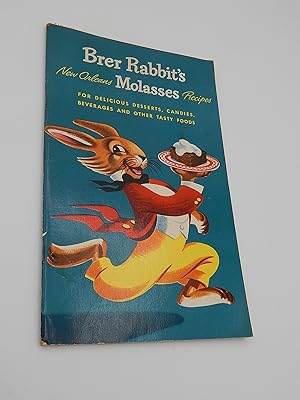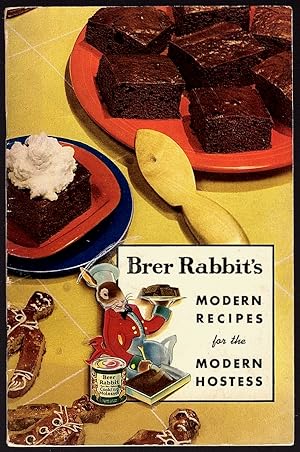PENICK AND FORD, LTD (3 résultats)
Type d'article
- Tous les types d'articles
- Livres (3)
- Magazines & Périodiques
- Bandes dessinées
- Partitions de musique
- Art, Affiches et Gravures
- Photographies
- Cartes
-
Manuscrits &
Papiers anciens
Etat
- Tous
- Neuf
- Ancien ou d'occasion
Reliure
- Toutes
- Couverture rigide
- Couverture souple
Particularités
- Edition originale (1)
- Signé
- Jaquette
- Avec images (2)
- Sans impression à la demande
Pays
Evaluation du vendeur
-
Brer Rabbit's Molasses Recipes: For Delicious Desserts, Candies, Beverages, and Other Tasty Foods
Edité par New Orleans: Penick and Ford, Ltd, 1948
Vendeur : Lee Madden, Book Dealer, Brattleboro, VT, Etats-Unis
Livre
Soft cover. Etat : Very Good. Very Good softcover. Staple-bound pamphlet with thin card pictorial covers. Bright, clean covers; tightly bound; slight age darkening on inside covers; bright, clean interior. 12mo, 48 pp; illustrated.
-
BRER RABBIT'S MODERN RECIPES FOR THE MODERN HOSTESS
Edité par Penick & Ford, Ltd. [1940], New Orleans, 1940
Vendeur : Champ & Mabel Collectibles, San Pedro, CA, Etats-Unis
Stapled wraps. Etat : Good +. 48p. Pages foxed and lightly creased, a bit of pencil marginalia with a few pages dog eared. Promotional booklet for Brer Rabbit Molasses includes recipes for gingerbread, cakes, cookies, pies, entrees, puddings, breads, candies, and desserts. B&w photographs. (7-3/4"x5-1/4").
-
Brer Rabbit's New Orleans Molasses Recipes for delicious desserts, candies, beverages and other tasty foods
Edité par Penick & Ford, LTD., Incorporated, New Orleans, LA, 1948
Vendeur : Ground Zero Books, Ltd., Silver Spring, MD, Etats-Unis
Edition originale
Wraps. Etat : Good. Format is approximately 5 inches by 8 inches. 48 pages plus covers. Decorative cover. Illustrations (some in color). Index of recipes. Cover has some wear and soiling. Penick & Ford, Ltd. was founded in 1897 by William S. Penick and James P. Ford in Shreveport, Louisiana. Its industry is specialty food ingredients and its headquarters were in Shreveport, Louisiana (1897-?), Bellevue, Washington (?-2002) and Englewood, Colorado (2002-present). It reorganized in 1920 following the acquisition of Douglas Starch Works. The company was acquired by the R. J. Reynolds Tobacco Company in 1965. The business was sold to the Univar Corporation in 1971. Univar spun off its manufacturing operations including Penick & Ford into a new company, Penwest, Ltd. in 1984. In 1997, the Penford Corporation was formed as a holding company. Both firms were acquired by Ingredion, Inc. in 2014. P&F produced many private labelsâ "Brer Rabbit Molasses, Brer Rabbit Syrup, Penick Syrup, Penick Salad Oil, Douglas Starch, Penford Corn Syrup, Penford Corn Sugar, and Douglas Feed. Under Bedford 's leadership, they acquired other grocery lines, including Vermont Maid Syrup in 1928 and My-T-Fine Desserts in 1934. For more than 100 years, Brer Rabbit® has been a trusted household brand used in cherished family recipes. Made of the finest quality unsulfured juice of sun-ripened sugarcane, Brer Rabbit sugarcane molasses contains no preservatives, artificial flavor or artificial color. It's a key ingredient for baking and cooking. Brer Rabbit Molasses comes in three grades: mild flavor, full flavor and blackstrap. All three grades are unsulfured molasses, making them the finest quality of sugarcane molasses available. Brer Rabbit is also available in two syrup varieties: full and light flavors. The Brer Rabbit name comes from the mischievous Br'er Rabbit from the Uncle Remus folktales passed down by oral tradition in the 1800s and popularized for mainstream audiences in the late 19th century by the published works of Joel Chandler Harris. In these tales, Br'er Rabbit is a trickster who wins by using his wits instead of brawn. Trickery and fun can certainly come in handy in the kitchen as you create winning dishes with Brer Rabbit! Br'er Rabbit (an abbreviation of Brother Rabbit, also spelled Brer Rabbit) is a central figure in an oral tradition passed down by African-Americans of the Southern United States and African descendants in the Caribbean, notably Afro-Bahamians and Turks and Caicos Islanders. He is a trickster who succeeds by his wits rather than by brawn, provoking authority figures and bending social mores as he sees fit. Popularly known adaptations of the character was originally written by Joel Chandler Harris in the 19th century, and later by Walt Disney Productions adapted it for the film Song of the South in 1946. In a detailed study of the sources of Joel Chandler Harris's "Uncle Remus" stories, Florence Baer identified 140 stories with African origins, 27 stories with European origins, and 5 stories with Native American origins. Although Joel Chandler Harris collected materials for his famous series of books featuring the character Br'er Rabbit in the 1870s, the Br'er Rabbit cycle had been recorded earlier among the Cherokees: The "tar baby" story was printed in an 1845 edition of the Cherokee Advocate, the same year Joel Chandler Harris was born. Rabbit and Hare myths abound among Algonquin Indians in Eastern North America, particularly under the name Nanabozho. The Great Hare is generally worshipped among tribes in eastern Canada. In "That the People Might Live: Native American Literatures and Native American Community" by Jace Weaver, the origins of Br'er Rabbit and other literature are discussed. Although the Cherokee had lived in isolation from Europeans in the remote past, a substantial amount of interaction was to occur among North American tribes, Europeans, and those from the enslaved population during the 18th and 19th centuries. It is impossible to ascertain whether the Cherokee story independently predated the African American story. In a Cherokee tale about the briar patch, "the fox and the wolf throw the trickster rabbit into a thicket from which the rabbit quickly escapes."[16] There was a "melding of the Cherokee rabbit-trickster . into the culture of African slaves. Presumed First Edition, First printing thus.




